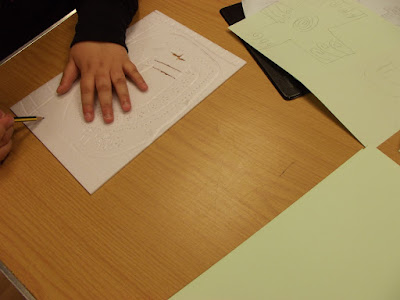 |
| Printing using polystyrene tiles |
One of the things that I really enjoy about my work is the variety of people I work with and the different groups and organisations I work with. Recently I did a workshop at Tullie House for a group of children with additional learning needs from Whitehaven school. The workshop was organised and paid for by Cumbria's Decorative and Fine Arts Society with the aim of giving the students an opportunity to explore the museum and work with an artist, a chance they may not otherwise have had.
 |
| In the Roman gallery |
 |
| Sketches made in the gallery |
 |
| Developing sketches into designs |
We began the day with a visit to Tullie's Roman Frontier gallery. The gallery assistant had a selection of objects for us to handle and was very knowledgeable and helpful. I gave each of the students paper and a clipboard and asked them to make sketches or notes about any object that particularly caught their attention so that we could use these as starting points for our prints in the afternoon.
 |
| Transferring designs onto the polystyrene |
 |
| Transferring designs onto the polystyrene |
 |
| Transferring designs onto the polystyrene |
As we were looking round the gallery I found lots of objects that I was interested in too and I made a few sketches. As time goes on I find more and more that everything is connected and I try now to use any opportunity I can to match up my personal art practice with my participatory practice. I particularly liked some of the sections of armour in the gallery, they were like scales or feathers and I was drawn to the rusted and decayed surfaces.
 |
| Printing |
 |
| Printing |
 |
| Printing |
After looking around the gallery we started working on designs for our prints. Because I had no idea of the level of ability I would be working with until I met the students on the day I had planned an activity that could be adapted to suit a range of needs. I had planned to use polystyrene tiles as print blocks, they can be marked with pencils to create an effect similar to lino prints but without the carving tools! This is a good activity for a range of abilities because simple mark making can create interesting prints but students with more experience and skill can make more planned designs.
 |
| Printing |
 |
| Printing |
 |
| Printing |
Designing their prints was the part of the process the students struggled with most, with the biggest barrier being a lack of confidence. Once they got going and with a bit of encouragement they made some really lovely designs. I tried to encourage them not to worry about drawing the objects exactly but to pick out the details that interested them. In this way some of the students were able to produce some really effective and inventive designs.
 |
| Printing |
 |
| Printing |
 |
| Printing |
Once they'd made their designs we transferred them onto the polystyrene tiles. As before I encouraged them to experiment and try different ways of marking the tiles to produce different effects when we printed with them. We then moved onto the printing which is my favourite part of the process. I like printing because you can produce multiples but each one is unique, little quirks in the way the ink is transferred producing a slightly different effect each time. I also like the anticipation of making the first print, seeing if it's worked and the satisfaction of a successful print or figuring out why a print didn't work.
 |
| Finished prints |
 |
| Finished prints |
 |
| Finished prints |
This was also the time the students started to come out of themselves a bit more, with some of them getting really enthusiastic and fired up and experimenting with mixing the inks and even printing in stripes! Each student produced a successful print and I was really impressed with some of the finished prints. I really enjoyed the day and working with the students and I hope they got something out of it too.
 |
| Finished prints |
 |
| Finished prints |
 |
| Finished prints |
 |
| Finished prints |
 |
| Finished prints |
 |
| Finished prints |
bokep terkini This is a very good post. Just wonderful. Nice one foto foto mesum
ReplyDeleteThis is great, you are good, i like your post and i still waiting our next post!
ReplyDeletefoto bugil jepang | bule bugil | foto model bugil